

Triaenodon obesus (Rüppell, 1837), (HEMIGALEIDAE). WHITETIP REEF SHARK
Giovanni Bassey
Recursos Marinos y Costeros, Programa de Investigación
Area de Conservación Guanacaste
e-mail: acg@acguanacaste.ac.cr
PUBLICATION:
Marine and Coastal Species Home Pages of the
Area de Conservación Guanacaste. http://www.acguanacaste.ac.cr/marinos/t_obesus/t_obesus_ing.html
July 25, 1997
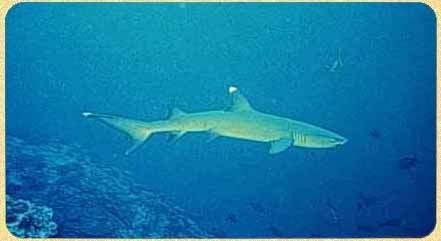 |
|
I. Identification:
This species is easily recognizable by its slender and elongated form, not very characteristic of the well known and common sharks of the world.
|
This species of shark was described in the first half of the XIX century and belongs to the family Hemigaleidae. This species, also known as the weasel shark, has white coloring on the superior sections of its dorsal and rear fins. The second dorsal fin and the inferior lobule of the rear fin frequently, but not always, have a white marking as well. |
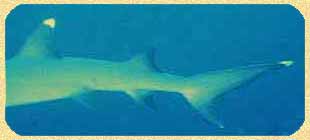 |
It differs from two other sharks in the family Carcharhinidae, who also present white or silverish markings in the points or wide zones of their fins in that these other two species, Charcharhinus longimanus oceanic whitetip shark and Charcharhinus albimarginatus silvertip shark, present the coloration in all their fins and have the characteristic heavy body and massive heads of the Charcharhinides. In some ocassions, Hemigaleidae has been consideres as a subfamily of Carcharhinidae.
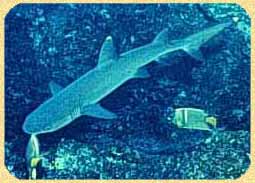 |
Other diagnostic features of Triaenodon obesus include two unequally sized dorsal fins, absent or reduced spiracles, compressed head with greater thickness than deepness, snout short and flat, grayish-blue clorign in the body with a slight yellow on the ventral section. It can be up to 210 cm long. |
II. Distribution
The members of this family are characteristic of the Ino-Pacific region and the eastern regions of the Atlantic. Triaenodon obesus also presents and Indo-Pacific distribution, but it is also commonly found in the Eastern Pacific, frquently in the Galapagos Archepelago, and in Cocos Island, as well as in other oceanic islands of tropical America and the continent.
In Costa Rica, this species is frequently found throughout the coast, commonly associated with coral reef formations like those present in Caño Island (in southern Costa Rica) and specifically in northwestern Costa Rica where a large number of the observations are in coastal islands of the Gulf of Papagayo like the Catalinas and Brumel Islands.
| This species is found throughout the marine and coastal zones of theArea de Conservación Guanacaste including the Murcielago Islands. | 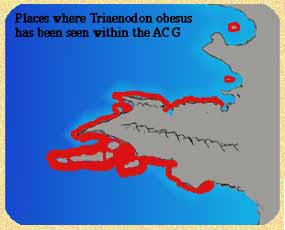 |
III. Natural History
This species is active at night. During the daytime it can be observed on the ocean floor or underneath rock formations and caves, both in groups and by themselves.
This shark feeds mainly on fish as well as cephalopods. It is not considered an aggressive nor curious shark and commonly allows divers to get close to it. Nevertheless, bright lights at night can bother it.
One of the characteristics that have made sharks very successful for 300 million years is its reproductive system. Contrary to many species of fish whos fertilization occurs in the water, sharks present internal fertilization. Triaenodon obesus is a vivaporous species (young sharks come directly from the mother instead of eggs). Breeding occurs in an aggressive manner, since the male bites the dorsal regions of the female, sperms enters in the female reproductive organ through the pterigopod which is an extention of the pelvic fin.
IV. How to find it
Individuals of this species can be found laying in the bottom of the ocean and close to coral reef formations.
They are not usually captured by fishermen because its meat is spongy and its fins can not be used. The shark is not attracted by bait placed by humans. It is sometimes trapped when it gets entangled with fishing nets.
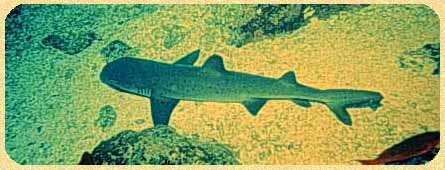 |
|
 |
 |
 |
Photography
G. Bassey, ACG, Cocos Island, July 1994.
References
Allen, G. R., & D. R. Robertson. 1994. Fishes of the tropical eastern pacific. University of Hawaii press .Honolulu, Hawaii.
Gilbert, P.W. 1985. "s.t." Mundo científico, Vol 4 (40). Etología. 942-952.
Eschmeyer, W.N.,E.S.Herald, & H.Hammann. 1983. A field guide to pacific coast fishes. Houghton Mifflin Company.Boston, Massachusetts, USA.
Goodson,G. 1988. Fishes of the pacific coast.Stanford University Press. Stanford, California, USA.